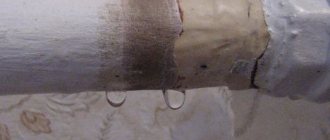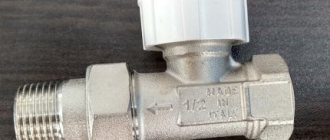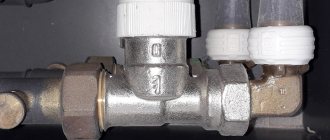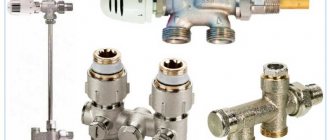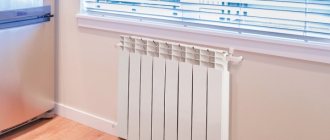Any homeowner doesn't want to have to replace their entire heating system because of a couple of leaks. Most often, the old circuit is made to last and can last for many years. And the most critical places gave in the slack. Let's figure out how to choose the right sealant for a heating radiator and how to eliminate a leak without completely dismantling the system.
The heating radiator is leaking Source slavasozidatelyam.ru
Types of sealants and requirements for them
Before the advent of special compounds, home craftsmen tried to use various folk remedies to repair leaks in the heating circuit. One of them is regular dry mustard. It was introduced into the water and launched into the system. The powder thoroughly clogged the small hole and the heating pipeline continued its work.
True, not very long. A side effect of such repairs is the inevitable failure of filters, as well as any other equipment. For example, a heating boiler. Therefore, homeowners were incredibly happy when the chemical industry began producing special and safe sealants.
Today, there are several different compositions for repairing heating systems:
- For external use.
- Internal volumetric use.
- For repair and sealing of threaded connections.
Any sealing material must provide complete isolation of water leakage in a short time. This is necessary so that the owner can prepare for a major overhaul of the system without turning off the heating in the house. But most often, most compounds are able to patch a small hole efficiently and for a long time.
Using sealant together with masking tape Source radiator-expert.ru
Requirements for sealants for water heating radiators:
- heat resistance;
- good adhesion;
- fast setting;
- high hardening strength;
- ease of use;
- safe use.
Almost all products produced by the chemical industry meet these parameters. And before choosing the type of sealant, it is necessary to diagnose the degree of damage and accessibility to the repair site. Let's take a closer look at how to properly use each category of adhesives.
Pros and cons of aluminum radiators
The popularity of aluminum batteries is explained by the following advantages of the products:
- Light weight. The weight of one section does not exceed 2 kg.
- Cheapness. Aluminum is a common metal that is easy to process.
- Easy installation and maintenance. The coating is heat-resistant paint that is easy to clean.
- Excellent decorative characteristics.
- High level of heat transfer. This is facilitated by additional ribs with thin walls. According to this indicator, aluminum radiators are almost 3 times superior to conventional cast iron batteries.
- Compact sizes.
- Fast response to temperature switching due to the low thermal “inertia” of aluminum.
Weaknesses of aluminum radiators:
- Very sensitive to the composition of the coolant (hardness, mineralization). Poor water quality often causes equipment failure. Therefore, deciding which antifreeze is best for a radiator must be taken seriously.
- Tendency to corrosion. Design, installation and repair must be carried out very carefully.
- Working pressure restrictions.
- High probability of formation of air pockets due to the chemical activity of the metal with salts dissolved in water
The choice of coolant for aluminum radiators must be done very carefully.
For external use
Not every product is suitable for repairing hot water pipelines. Manufacturers produce sealant to eliminate water leaks using three types of main raw materials. Acrylic, silicone and polyurethane are used for it.
The first one is completely unsuitable for a heating system. Acrylic sealant loses its plasticity when it hardens. As a result, temperature deformation can destroy the base. Therefore, this composition is used only for repairing cold water supply.
Sealant for threaded connections Source radaprom.ru
Before purchasing sealant, you must carefully read the labeling on the package. For sealing small holes in a heating radiator, only a heat-resistant compound is suitable. The operating temperature range should also be indicated in the instructions.
Products based on silicone and polyurethane meet these requirements. But the latter glue is mainly used for construction work. Although its properties are quite acceptable for use in a heating circuit. It is quite elastic and has good adhesion. Able to withstand high liquid temperatures and excellent resistance to corrosion processes.
But only some of its brands have such characteristics. Therefore, when choosing, you must read the manufacturer’s recommendations. In addition, most polyurethane compounds are two-component. They are difficult to work with because after mixing with epoxy resin, the glue hardens very quickly and loses its plasticity. And good one-component products are very expensive.
Silicone sealant on a neutral basis Source kronas.com.ua
See also: Catalog of companies that specialize in engineering systems (heating, water supply, sewerage and others) and related work
The best sealant for heating pipes is made from rubber-based silicone. Its characteristics satisfy all requirements. In addition, you can significantly enhance the effect of application if you apply it to a reinforcing mesh. But you also need to be careful with this choice.
The fact is that some silicone sealants contain an acid base. And it is strictly forbidden to use them to repair metal surfaces. When hardened, acetic acid is formed, which will inevitably cause corrosive processes. Therefore, for iron pipes with hot water, you need to choose either alkaline or neutral compounds.
How to use silicone sealant
Experts recommend using serpyanka as a supplement. This masking tape will act as a reinforcing mesh. Such a combination of sealant for the heating system and serpyanka will significantly increase the reliability of the patch and significantly extend its service life.
Masking tape (serpyanka) Source forum-dag.ru
Step-by-step actions when repairing heating pipes:
- The emergency area is dried. Then it is thoroughly cleaned and degreased.
- A layer of sealant is applied to the surface.
- A row of serpyanka is wound on top. In this case, the turns must be placed strictly at the joint.
- Then the sealant is applied again.
- And once again they wind the serpyanka. But the coils are already laid with an overlap of 1 cm.
- It is necessary to make at least four such alternating layers, preventing air from getting inside.
- The last to be wound are 2-3 layers of serpyanka without glue. And they are securely fixed with nylon clamps.
- After the silicone has hardened, the excess turns of the painting mesh with clamps are cut off.
- The final layer of sealant is applied over the resulting structure and smoothed well. It's called "repair".
Work is carried out at an ambient temperature of no less than +5 degrees Celsius. In this case, it is necessary that the silicone itself is heated to +18 °C. The hardening time of the composition depends on its type. But basically the layers harden at a rate of several millimeters per day.
Checking the battery after repair Source jackwharperconstruction.com
Use of solid fuel boilers
When deciding how to heat a private house without gas, you may prefer a solid fuel boiler. This heating option has become especially popular in European countries. This type of solid fuel units can provide economical heating, as well as ease of operation. Such devices operate not only on wood, but also on pellets, coal, and peat. Heat will be supplied through the pipeline thanks to water, which acts as a coolant. This heating method allows you to maintain the required temperature inside the premises for a long time, all this is ensured thanks to a sufficiently long burning of fuel in just one load.
Liquid formulations
It happens that the leak is not visible, but the volume of the coolant liquid gradually decreases. And the pressure generated by the circular pump has dropped. This can happen if there is hidden pipework. For example, they are partially in the walls. Or a heated floor system has been installed.
Dismantling the cladding is a labor-intensive and expensive task. And in this case it is better to use liquid sealant for hidden leaks. It is poured into the heating system and independently seals the hole from the inside. The product is also perfect for batteries. When the leak itself is visible, but it is not possible to apply a clamp or patch to this place.
But you need to use the liquid adhesive without haste. If the pressure in the system has dropped, this does not always indicate a hidden leak. First you need to inspect the expansion tank. Perhaps the membrane in it simply collapsed. That's why the pressure dropped.
Dilution of liquid sealant with coolant Source infourok.ru
There are quite a few types of liquid formulations. And each of them works well only under its own optimal conditions. Sealants are divided mainly by type of coolant (water or antifreeze) and pipeline material (metal or plastic). Therefore, when purchasing, you must carefully look at the labeling and be sure to read the instructions from the manufacturer.
Liquid sealant for the heating system is purchased in a strictly defined quantity. This is due to its operating principle. The particles dissolved in the coolant remain in a neutral state until they come into contact with air. It is in the area of the hole that polymerization begins to occur.
The particles harden and clog the crack from the inside. This is why the concentration of the solution used is so important. And for this it is necessary to calculate the entire volume of the heating circuit. In order to dilute the required amount of the composition in accordance with the instructions.
To determine the total volume, find the necessary data in the technical data sheets of the boiler and radiators. Then measure the length of the pipeline and multiply the resulting value by the diameter of the pipe. All results are summed up. And for those who do not trust calculations, you can drain all the coolant into one container and in this way find out the volume of the system.
Applying a mask
To achieve a visible result, before applying the mask, you need to steam your facial skin well and open the pores. To do this, hold your cleansed face over a steam bath prepared with a series of steam baths for about ten minutes.
- Wipe your face dry and immediately apply the prepared black mask to it. Be careful that the mixture does not cover your eyebrows, because when it hardens, the mask will pull out the hairs along with the blackheads.
- The effective effect is about fifteen minutes, after which wet the mask a little with warm water using a spray, grab it by the lower edges and slowly pull the film up with your hands.
- Apply moisturizer to your face and avoid going outside for one hour.
The frequency of use of this black mask directly depends on the condition of your skin. If you use it for preventive purposes, once a week is enough. In the case when the facial skin is neglected and a lot of blackheads and pimples appear on it, it is recommended to make masks twice a week. The duration of treatment is from two to three months.
The availability of components and knowledge of how to make a mask for blackheads at home will help bring problematic facial skin into order. The main thing is that when purchasing ingredients at the pharmacy, be sure to check that they are all fresh, as the effectiveness of the mask depends on this. There are no contraindications identified, so feel free to start cleansing blackheads at home.
There are plenty of recipes for black masks. You can switch to a different “composition” after each course, or you can always stick to one. But dermatologists and cosmetologists recommend changing skincare products every six months, since the skin develops immunity to them and over time the effect of masks will become weaker.
Seals
Radiator sealant is also successfully used for all threaded connections. Sometimes it is used instead of (or together with) FUM tape, which has completely replaced flax tow. There are liquid and paste formulations. They can harden completely or remain elastic throughout use.
Among the pastes, the Unipack brand is popular. It does not harden and contains flax fibers. Its main advantage is the ability to protect the joint from corrosion. And if necessary, it can be easily removed.
Anaerobic drying pastes are vibration resistant and can withstand temperatures up to +200 °C. Their only disadvantage is the inability to tighten the threaded connection if necessary. In this case, all tightness is immediately broken. Among the products, the PERMATEX brand is in wide demand.
The main advantages of polypropylene products
Among the advantages of polypropylene structures, one cannot fail to highlight the following:
- high strength and tightness;
- excellent soundproofing qualities;
- high elasticity allows the material to stretch up to 7% of its own volume without compromising its functionality;
- resistance to high temperatures;
- ease and convenience during installation.
Briefly about the main thing
Sealants for heating system repairs are successfully and irrevocably replacing outdated clamps. With their help, you can reliably eliminate leaks in the pipeline. Moreover, the patch is guaranteed to last the entire life of the heating circuit.
Liquid sealant will be indispensable where the heating pipeline is partially embedded in the wall or located under the floor. In this case, the leak cannot be detected. And a special compound pumped into the system will plug the crack from the inside and on its own.
What to consider
The heating system of a dacha uses many elements, connections, valves, and adapters. It must be taken into account that ethylene glycol-based antifreeze is a more viscous, viscous substance than water, and all connections and adapters must be more tight and thorough.
Antifreeze can heat up to 170 degrees. In this case, it begins to decompose, which will negatively affect the entire autonomous heating system of the dacha. To do this, the system must provide constant, continuous circulation of antifreeze. If used correctly, antifreeze will last 10 seasons, then it should be replaced.
How to choose?
It is important not just to choose a sealant for the radiator, but also heat-resistant options to eliminate leaks. If you notice that a joint is leaking somewhere near the batteries, you need to decide which sealant will help, and reviews can help in this matter.
The choice of sealant is made based on the problems that it must solve to eliminate leaks in the heating system. If it will be used to seal the joints of the heating system, then paste-type silicone sealant is perfect for these cases.
It can be drying or non-drying version.
Differences between sealants may include the following:
- Drying compounds. After the composition applied to the surface dries, it has the ability to shrink, but this happens if the drying technology is broken. Thus, deformation of the composition may occur, cracks and drips may appear.
- Non-drying compounds. Ideal for removing small cracks and can also be used to seal heating system joints. But such compounds can be squeezed out if the pressure in the system exceeds the normal value.
Aerobic-based compounds, which are considered a type of acrylic sealants, are used in some situations to eliminate defects and leaks in heating systems. This type of sealant is able to withstand temperature changes, is resistant to mechanical stress and is resistant to alkali and acid solutions. If you apply it to the site of a defect, it quickly fills the defect and dries.
It can be used to seal the threaded connection of the heating system, but if you later dismantle one or another section of the radiators, it will be difficult.
Conclusions and useful video on the topic
During the process of sealing a sewer system, many questions arise. We offer video materials that will help you cope with difficulties and complete all the work yourself.
Instructions for sealing sewer pipes using silicone sealant:
We offer video instructions on how to properly mix epoxy resin and hardener:
Do-it-yourself video tutorial on sealing the socket of a cast-iron external sewer:
Detailed instructions for sealing the socket of sewer pipes when switching from cast iron to plastic:
Whatever type of sealant for sewer pipes you choose, you need to carefully prepare the surfaces and perform the work efficiently. There should be no cracks or fistulas on the pipes. Before sealing, they are cleaned, repaired, and degreased.
When working, you should strictly adhere to the technology, and after finishing it, wait the allotted time until the composition hardens. Only after this the system can be operated normally.
Do you have experience sealing sewer pipes? Please share information with our readers and suggest your method of solving the issue. You can leave comments in the form below.
Popular brands
The market offers sealing materials for stoves, fireplaces and chimneys. They are selected according to their composition and operating temperature. It is recommended to use products from reputable manufacturers.
Soudal
Soudal (Saudal) is a Belgian company that specializes in the production of sealing compounds. Soudal sealant for stoves and fireplaces is the Soudal series.
Calofer, heat-resistant compounds in black. Materials based on sodium silicate do not emit toxic substances when heated and can be painted. Suitable for sealing cast iron elements of boiler units. One of the advantages of Belgian products is their resistance to cracking and crumbling.
Penosil
An Estonian company produces silicate paste for Penosil +1500 ovens. The material has high heat resistance and is black in color. Foam is cheaper than the products of the famous Belgian manufacturer, but is not inferior in quality. This makes Estonian sealant widely in demand among professionals and home craftsmen. The company's product line also includes the silicone sealing compound Penosil Hight Temp, suitable for use for moving joints due to its elasticity.
Tytan
Under this brand, sealing compounds are produced by the Selena Group, a group of Polish manufacturers of professional materials for construction and finishing. The sealing paste contains fiberglass, which provides the sealed seams with increased gas tightness. The material is designed to be heated to high temperatures (1250 degrees), which makes it suitable for sealing seams and cracks in fireplace and stove masonry, and for installing chimneys. Products of the Tytan brand, as well as sealants with similar properties, which are produced under the Baumaster brand, belong to the middle price category. In terms of price and quality ratio, this is the best option for a wide range of consumers.
Makroflex
A well-known Estonian manufacturer of sealing materials supplies the market with fire-resistant silicate composition Makroflex HA147. It can withstand short-term heating up to a high temperature of +1500 degrees and exposure to an open flame. The advantages of the paste of inorganic materials include adhesion to most materials used in construction and the absence of shrinkage upon drying and under the influence of temperature fluctuations.
Krass
The Russian manufacturer offers the refractory composition “Krass fireplaces and stoves”. Using this material, fireclay masonry and fireproof masonry can be installed in the furnace firebox. The composition can withstand sudden increases in temperature, is not afraid of open fire, and is suitable for repairing brick stoves and fireplaces, as well as heating boilers. This is a non-shrinking material made on the basis of liquid glass. Thanks to its paste-like consistency, it is easy to apply.
Peculiarities
Thanks to sealing compounds, the construction and renovation process becomes simple and fast. With their help, you can reliably fasten various surfaces together without nails or a hammer, use them as a sealing agent and for sealing cracks and cracks. When installing windows or troubleshooting minor problems in everyday life, they are indispensable, saving money and time. Their use allows pipes to be repaired without opening walls or removing plumbing structures.
Liquid sealant is currently stronger than glue, but not as “heavy” as mortar.
The sealing liquid has a number of properties:
- does not change its characteristics under the influence of high temperature;
- is moisture resistant;
- withstands heavy loads.
The liquid solution is one-component, comes in tubes and is ready for use. The product for larger-scale work is available in canisters of various sizes.
Fill
Approximately a bucket of heated coolant is poured into a separate clean container. In the other - another half bucket (for future washing). The product is worth chatting and pouring into a bucket. Make sure that the sealant does not come into contact with air for a long time. It needs to be quickly pumped into the heating system.
Again the air is removed from the networks.
The sealant circulates through the heating circuits for several hours. The process of sealing gaps and leaks will be completed in four days. On the fifth day, you need to test the system under high pressure.
And remember, heating system sealant is definitely worth using to prevent leaks. And even though its cost will seem quite high to many. Hidden reconstruction of heating pipes is both a convenience and, at the same time, a certain risk, for which you sometimes have to pay.
K-Seal
Not the most popular sealant for car radiators on the domestic market. It has average characteristics and costs slightly more than its analogues. It sets quickly, but the time varies greatly depending on the width of the defects. For example, it closes a 0.3 mm gap in a little more than a minute, and to seal a 1 mm hole, it will take more than 6 minutes.
A high-quality protective plug is created by containing copper powder in the composition. The advantage is that there is a small amount of residual substances, the system is not clogged as much. Can be used with various antifreezes without harm to the radiator. The downside is the high price.
Results
Discussions on the topic of whether it is possible to pour antifreeze into aluminum radiators brought very specific answers.
Responsibility for choosing a coolant lies entirely with the owners of the household. When considering various liquid options, one should keep in mind one more feature of systems filled with antifreeze coolant. If the operating temperature regularly exceeds the limit of +70ᶷ degrees, it is better to refrain from using antifreeze solutions, because because they have a very high expansion due to the alcohol content. This is fraught with pipeline ruptures and damage to heating devices. Date: September 25, 2022
Why is tightness needed?
Brick stoves and fireplaces are prone to cracking due to uneven heating of the masonry, especially if it is not protected by a layer of plaster or tiles. If the cracks in the body of the heating unit turn out to be through, this entails unpleasant consequences
:
- fuel is consumed faster because it burns under conditions of additional oxygen;
- soot may enter the room and settle on the walls and ceiling;
- combustion products enter the room, primarily carbon dioxide, which can cause poisoning.
Cracks in a brick chimney, cracks in a metal pipe for removing combustion products reduce draft, and the heating unit cannot operate in optimal mode. This causes the fuel to burn at lower temperatures, producing a lot of ash and more soot deposited on the inside of the chimney.
A large amount of soot and a leaky chimney is a dangerous combination. The intake of air causes the soot to ignite, and it burns at temperatures above 1500°C, causing the chimney to heat up. An insufficiently thick layer of thermal insulation around the pipe will not save wooden structures from charring; there is a serious risk of fire.
For gas boilers, a leak in the chimney results in gusts of wind extinguishing the burner. To avoid the need to regularly check the operation of the boiler, the gaps in the chimney duct are sealed with a special sealant.
Flaws
The latest generation of polymer thread adhesive also has its disadvantages. They are not as significant as those of mechanical sealants, but you need to know them:
- not recommended for use for pipes with a diameter larger than M80;
- low temperatures significantly increase the polymerization time of the solution;
- Can only be used on dry surfaces.
For many buyers, the downside is the cost. It is higher than other types of seals. However, taking into account the economical consumption, high quality and reliability of the joints formed, and the reliability of sealing, the price of aerobic glue is completely justified.
Recommendations
The need to provide a strong seal to drain or sewer pipes arises when the system is displaced. In order not to return to such a process after some time, it is worth considering the following features:
Apply sealants taking into account the temperature effect. Tighten the thread with a wrench to reduce clearance. When choosing, pay attention to the area of application: indoors or outdoors. Some sealants cannot be painted, so you need to look at the color. Professional formulations are more difficult to use.
The installation of water pipes implies not only proper fastening, but also protection from negative influences. Sealing compounds will help guarantee a long service life and reliable protection against water leakage.
